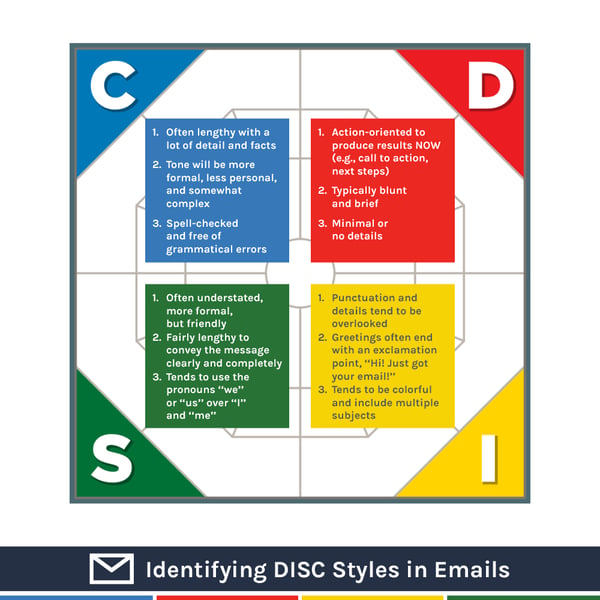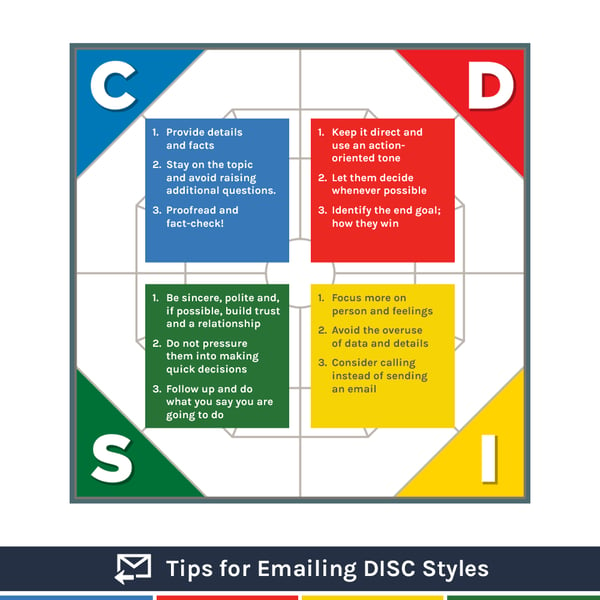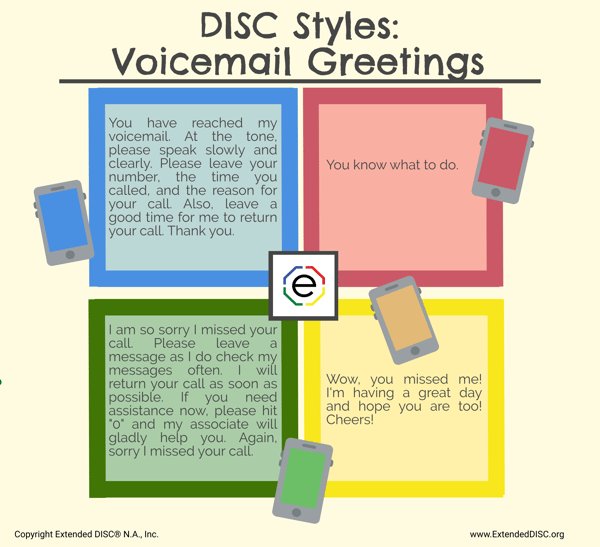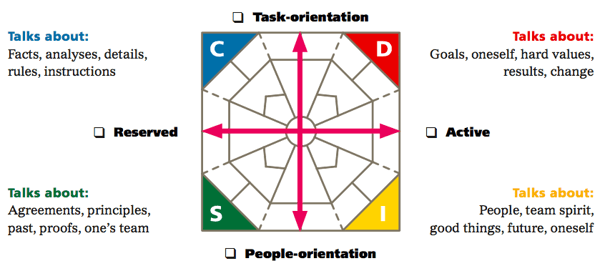How often would you say your interactions occur face-to-face versus emails and phone calls?
Face-to-face communication has given way to other forms of daily interactions. Virtual communication refers to our interactions when they are not face-to-face. We commonly use webcams, voicemails, and emails to connect in our workplace and personal lives. Connecting virtually is a fact of today's business world and how well we interact does impact our productivity and how successful we can be.
 DISC can improve our virtual interactions. Mastering DISC communication applies to all of our interactions; whether it's face-to-face or other ways. It encompasses a few basic steps including an understanding of DISC styles, understanding our own style, identifying the style of others, and adjusting our style.
DISC can improve our virtual interactions. Mastering DISC communication applies to all of our interactions; whether it's face-to-face or other ways. It encompasses a few basic steps including an understanding of DISC styles, understanding our own style, identifying the style of others, and adjusting our style.
DISC gives us an advantage to writing more effective emails. You can adjust the tone of your emails if you know the other person's preferences in their written communication. If you don’t know the other person, you'll need to identify their DISC style. You can do it by observing their writing style. Now, you can adjust the tone of your emails to make it more task-focused, detailed, personable, etc. It can mean the difference between generating a desired response or not.
Another virtual form of communication is via the phone. Identifying DISC styles via the phone is part science, part art, and all practice. You and the person you’re calling will form opinions based primarily on the words used, like in a greeting, and the tone of your voices. Just like written communication skills, effective phone skills can be enhanced by understanding DISC. We are often told to be friendly, listen actively, and be courteous, but that may not be enough. We are assuming that the person on the other end of the phone wants the same things. There are basic tips for better telephone meetings, but identifying DISC styles in others can give you a competitive edge.
Let's learn how DISC can help in building better interactions virtually!
DISC styles: emails
 Both of the task-oriented D-styles and C-styles prefer a task-oriented written communication style. However, the D-style prefers to focus on key, targeted information; therefore, executive summaries, highlights, and bullet points work best. D-style emails are typically brief, minimal, and action-oriented. They may skip the greeting and ignore correct grammar and punctuation. The tone of D-style emails tends to use command sentences, telling you to do something over asking you to do something. They prefer emails with a call to action or next steps so they can control what comes next. Remember, in your D-style emails, keep it simple, action-oriented, and provide options for them to make decisions and maintain a sense of control.
Both of the task-oriented D-styles and C-styles prefer a task-oriented written communication style. However, the D-style prefers to focus on key, targeted information; therefore, executive summaries, highlights, and bullet points work best. D-style emails are typically brief, minimal, and action-oriented. They may skip the greeting and ignore correct grammar and punctuation. The tone of D-style emails tends to use command sentences, telling you to do something over asking you to do something. They prefer emails with a call to action or next steps so they can control what comes next. Remember, in your D-style emails, keep it simple, action-oriented, and provide options for them to make decisions and maintain a sense of control.
I-styles see your email as a chance to call you to chat. Their favorite and possibly only punctuation mark is the exclamation point, “Hi! I just got your email!” If they do email back, the email tends to jump from subject to subject and is conversational to an extreme. The tone will come across as optimistic, breezy and people focused. It may lack details and hard facts. When emailing them, try to focus more on the person, avoid negativity and overusing details. Also, consider picking up the phone instead of sending an email whenever possible, especially if they don’t respond in a timely manner. The I-style will see it as an opportunity to chat and you are more likely to get the results you are looking for.
 S-style emails tend to be friendly, but more reserved. They may start with, “I hope this finds you well” and end with, "Warm regards" or "Sincerely". They are lengthy, in order to convey the message clearly and peppered with questions asking for more details. The emails tend to contain the pronouns “we” or “us” over “I” and “me” because S-styles focus on being a team player. In addition, they tend to use cooperative "asking" sentences over commanding "telling" ones. S-styles seek information so they can make the best decision for their teams. Try providing reassurance by answering their questions carefully, and progressing step-by-step. When emailing the S-style try using plural form when addressing them, "we" or “you and your team”. Also, be sincere and if possible, build rapport. Don't push them into quick decisions and be sure to follow up and do what you agreed upon.
S-style emails tend to be friendly, but more reserved. They may start with, “I hope this finds you well” and end with, "Warm regards" or "Sincerely". They are lengthy, in order to convey the message clearly and peppered with questions asking for more details. The emails tend to contain the pronouns “we” or “us” over “I” and “me” because S-styles focus on being a team player. In addition, they tend to use cooperative "asking" sentences over commanding "telling" ones. S-styles seek information so they can make the best decision for their teams. Try providing reassurance by answering their questions carefully, and progressing step-by-step. When emailing the S-style try using plural form when addressing them, "we" or “you and your team”. Also, be sincere and if possible, build rapport. Don't push them into quick decisions and be sure to follow up and do what you agreed upon.
C-styles often prefer written communication over face-to-face since they are naturally more reserved and more task-oriented. Their emails are more formal and tend to have a lot of details and facts. It probably has been spell checked. They will ask a lot of detailed questions and will not be able to progress further until they have all the information they need. C-styles want details and facts, which will allow them to respond correctly or make the correct decision. Your emails should be clear and contain data based on proven ideas. If possible, you can preemptively answer questions that clarify the information. Lastly, make sure to proofread!
Active styles: phone calls and voicemails
 D-styles tend to communicate in one direction, they talk and you listen. Phone calls, like their voicemail greetings, tend to be short, to the point (almost blunt), and action-oriented. They want to know, 'what's the bottom line?" They may interrupt and sound impatient. In fact, they may even be multitasking while they're on the phone with you because they are results-oriented. The next time you are on a call with a D-style consider being more direct, focusing on issues and less on details, acting faster, and avoiding small talk. You may not be used to the overbearing, aggressive and blunt tone, but stay focused on tasks and results.
D-styles tend to communicate in one direction, they talk and you listen. Phone calls, like their voicemail greetings, tend to be short, to the point (almost blunt), and action-oriented. They want to know, 'what's the bottom line?" They may interrupt and sound impatient. In fact, they may even be multitasking while they're on the phone with you because they are results-oriented. The next time you are on a call with a D-style consider being more direct, focusing on issues and less on details, acting faster, and avoiding small talk. You may not be used to the overbearing, aggressive and blunt tone, but stay focused on tasks and results.
When D-styles leave you a message, it tends to be loud, quick, and assertive, “This is Diana. Call me”. When leaving a message for a D-style, you might hear, “you know what to do,” and it's quickly time to leave your message. Remember, when leaving a voicemail for or calling the D-style, get to the point yourself, use an assertive tone, and avoid excessive details and chitchat.
The positive, and lively I-styles enjoy talking and chit chatting. They prefer to avoid unpleasant subjects and instead, talk about people they know. They do not listen for long and can get easily side-tracked. I-styles often stay away from hard facts; preferring to jump from subject to subject. Set aside extra time to chat when calling on an I-style. Let them speak and react positively and enthusiastically whenever possible. Be friendly and if possible, avoid too many details.
Voicemail greetings from I-styles are often exuberant, bright, and long, "Hi! I'm so sorry I missed your call! I'd love to talk to you so leave me a message! Have an awesome day!" Remember, when leaving a voicemail for the I-style, be friendly, positive, and don't overuse details. I-styles often leave animated and long-winded voicemails. They may forget details like providing a call back number and may not clearly provide the reason for the call.
Reserve styles: phone calls and voicemails
S-styles are amiable and active listeners. They tend to be more comfortable letting you speak, but will speak calmly when it's their turn. They will need time to think things through so don't push them for quick responses. Focus on answering their questions and consider ending the call with a date for a follow up call.
An S-style greeting may be, “Hello. I'm so sorry I missed your call. However, I do check my messages regularly and I will return your call as soon as possible. If you need assistance now, please hit “0” and my associate will gladly help you. Thank you." Voicemails, like their greetings, are typically calmer, pleasant, thorough, and slower paced.
If you are calling the C-style, you should expect to do more of the talking. Make sure to slow down and to answer questions carefully. If possible, send an email prior to the phone call to let them know the context of the call. Remember, the more information the better and know that you may need to follow up with additional information in an email.
The more formal C-style's greeting may be, “You have reached my voicemail. Please speak slowly and clearly. Leave your number, the time you called, and the reason for your call. Also, please leave a good time to call you back”. They will speak with less emotion, and at a slower tempo. Their own messages for you will include a high level of detail for the call. They may even follow up with a detailed email to make sure you have all the information.
DISC styles and video conferencing

Video conferencing allows us to verbally and visually communicate with each other when we can't be face to face. We have the ability to see and hear one another in as close to real time as possible, simulating the face-to-face experience. While you may not be able to shake their hand, you can still apply the Observe-Assess-Recognize process to identify the style of others, just as you would in written and phone communication.
 First, observe what the person tends to talk about, how they say it, and the tone and pace to which they speak. Are they animated or reserved? You can also look for verbal cues like eye contact and body language; do they use their hands when speaking or are they still? Next, think of the Extended DISC Diamond Model and assess what you've observed. Determine if the person is more Reserved vs. Active and more Task or People-oriented. The final step in the OAR Process is to recognize which main DISC style the other person may be. You may refine it as you interact more with the person. Most importantly, it is a skill that is relatively easy to learn and use, but as always, takes some practice.
First, observe what the person tends to talk about, how they say it, and the tone and pace to which they speak. Are they animated or reserved? You can also look for verbal cues like eye contact and body language; do they use their hands when speaking or are they still? Next, think of the Extended DISC Diamond Model and assess what you've observed. Determine if the person is more Reserved vs. Active and more Task or People-oriented. The final step in the OAR Process is to recognize which main DISC style the other person may be. You may refine it as you interact more with the person. Most importantly, it is a skill that is relatively easy to learn and use, but as always, takes some practice.
Practice adjusting
There is no one-way of successfully communicating with another person. However, any additional information you can acquire about the person, by observing their patterns of behavior and identifying their style, can help improve your interaction.
As with any mastery of DISC, you need to practice. Adjusting styles, when writing emails and making phone calls, may seem like extra work. However, the payoff may actually end up creating less work on your part because you can reach your goal quicker. For example, we all get a lot of phone calls and emails daily, right? People will react more positively and notice the difference when receiving a good email or engaging phone call. Your mastery of DISC could be the difference between getting overlooked and getting what you want. In addition, it can save frustration, time, and energy on both sides.
A few final tips
 It's very important to not jump to conclusions when identifying DISC styles of others. You can end up making interactions go in the wrong direction by adjusting too quickly; imagine what can happen if you assume too quickly that someone is an I-style. Let's say you pick up the pace, start to gloss over details, and become chattier. If they are, in fact, the more reserved S-style, they may shut down and withdraw. It's sometimes better to not make adjustments until you've identified some patterns of behaviors.
It's very important to not jump to conclusions when identifying DISC styles of others. You can end up making interactions go in the wrong direction by adjusting too quickly; imagine what can happen if you assume too quickly that someone is an I-style. Let's say you pick up the pace, start to gloss over details, and become chattier. If they are, in fact, the more reserved S-style, they may shut down and withdraw. It's sometimes better to not make adjustments until you've identified some patterns of behaviors.
Here's another great tip! You can create email templates based on each of the DISC styles, and that way you'll be one step ahead. Another tip is to add a client DISC style field to your customer relationship management program (CRM). Now, you and your co-workers can share valuable information about your clients to create more impactful interactions.
You'll be able to have more successful outcomes if you practice identifying styles of others and adjusting for those brief and temporary moments, whether it's face to face or virtually.
